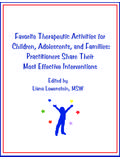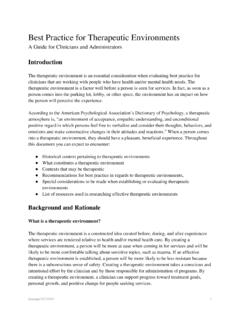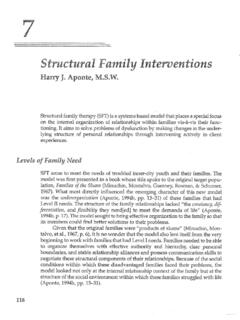Transcription of Modified Dialectical Behavioral Therapy: Interventions to ...
1 1 Modified Dialectical Behavioral therapy : Interventions to Enhance Emotional Regulation Skills and to Decrease Challenging Behaviors in Adults with I/DD Sherry C. Mergner, MSW, LCSW CIDD Chills Skills Modified DBT Group Two Groups on Thursday Afternoon 1 hour each Seven clients in group #1 and six clients in group #2 (3 men and 10 women; age range early 30 s to late 50 s; one African American and twelve Caucasian; 4 live in apartments with supports; 8 live in group homes; 1 lives in community). Diagnosis Group #1 Down syndrome; Anxiety and Depression Down syndrome and Depression I/DD, ADHD and Anxiety x2 I/DD, Borderline PD and ADHD I/DD, Intermittent Explosive Disorder; Somatic Complaints (possible PTSD/ASD/Depression/Anxiety) I/DD, Mild Depression (periods of selective mutism) Diagnosis Group #2 ASD, Anxiety, OCD ASD and Depression Turner s syndrome, mixed depression and anxiety I/DD and Impulse Control CP, OCD and Anxiety CP, Depression and Anxiety Clients in group #1 have 30-minute individual therapy sessions every Thursday before or after group.
2 Five out of six member in group #2 have individual therapists (not necessarily at CIDD). Group #1 has been running for almost four years with the most of the same clients. Group #2 is in its second year. Agenda: Gratitude Journal; Meditation/Yoga; Check-in (one joy/one challenge); Skill Lesson and activity (practice, role play, art, etc.); Music/Dance One person graduated from the group #1 after completing all four modules, but continues to see me once a month for individual therapy . He has made significant improvement with anxiety, boundaries and interpersonal relationships.
3 We started out doing weekly homework assignment sheets, but did not seem to get a good return rate on those. We do encourage clients to practice skills and check-in with them each week at group and at individual sessions (if they have them). We have weekly DBT planning meetings where we plan future sessions and process previous session or specific client issues related to group. All my clients have my phone number and know they can call if they need support. We celebrate birthdays, holidays, and do a graduation ceremony at the end of each module New referrals go through a screening process.
4 We start and end each module with a pre/post-test. 2 What is DBT? DBT stands for Dialectical Behavior therapy DBT is a specific type of cognitive- Behavioral psychotherapy (CBT) created in the 1980 s by Marsha Linehan, , an American Psychologist An evidence based model of therapy that uses skills training and the therapeutic relationship to manage strong emotions, distorted thinking and Behavioral dyscontrol. A bio-psycho-social approach to psychotherapy that modifies traditional Behavioral approaches and combines them with Buddhist concepts like acceptance and mindfulness.
5 Uses group work (skills training), individual therapy and self-monitoring to change target behaviors. Originally created for the treatment of Borderline Personality Disorder, it is now used in a variety of treatment settings with a range of individuals, conditions or mental health disorders ( , dual diagnosis, substance use, eating disorders, complex trauma, suicidal adolescents; ASD, and IDD). DBT has been described as being designed for the severe and chronic, multi-diagnostic, difficult to treat clients with both Axis I and Axis II disorders. Cognitive Behavior therapy (CBT) CBT teaches individuals how their thoughts, feelings, and behaviors influence each other.
6 CBT teaches individuals to use this relationship between thoughts, feelings, and behavior to their advantage. This approach believes that positive change in one factor (changing a thought or behavior) can lead to positive changes in all factors. Evidence-based approach that has been proven to help individuals with various mental health issues such as depression, anxiety disorders or substance use problems. Also used with individuals with high functioning ASD (Michelle Garcia Winner s Social Thinking methodology). CBT is structured, goals-oriented and focused on the present.
7 CBT teaches skills and strategies like problem-solving or realistic thinking to help individuals make changes to their thoughts, feelings, and behaviors. Dialectical Behavior therapy (DBT) DBT is based on CBT, with greater focus on emotional and social aspects. DBT was developed to help people cope with extreme or unstable emotions and harmful behavior. DBT is an evidence-based approach which helps individuals regulate emotions, cope with stress and improve interpersonal relationships. It started as a treatment for borderline personality disorder, and current research shows it may help with many different mental health issues or concerns, particularly with self-harm.
8 The key differences between CBT and DBT are validation, acceptance and relationships. DBT teaches individuals that their experiences are real, and it teaches them how to accept who they are, regardless of challenges or difficult experiences. Relationships are important in DBT including the relationship between the client and the DBT practitioner Validation and acceptance is critical in the therapeutic relationship as well as in peer to peer relationships in group. What is Dialectics? The idea that two opposite or contradictory ideas can exist at the same time.
9 Simply said: It means two opposing things being true at once. 3 Thinking dialectically means we maintain openness to contradictory and/or polarized thoughts and points of view. We work to blend these thoughts into a truth which best explains the reality at the moment. Examples: You love your family member, but you are angry because they are always late. As a parent you are often doing the best you can AND you are still wanting to do better. Teenagers want to do things on their own AND they still rely on their parents. We accept the client where they are AND we still push them to change.
10 DBT therapists understand and validate, what clients are doing based on who they are, what they have been taught or what is in their history AND we believe that they can also become more skillful to have a better life. Five Main Tasks of the DBT Therapist Work to expand client capabilities. Motivate the client to engage in new behaviors. Generalize the use of the new behaviors. Establish a treatment environment that reinforces progress. Maintain capable and motivated therapists. Three Components Needed to Accomplish These Tasks Individual psychotherapy Skills training group Phone coaching Supervision/case consultation groups DBT is a Strengths-Based Approach to Working with Clients People are active participants in the helping process (empowerment).







